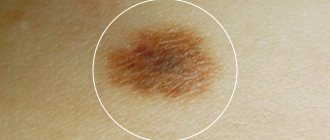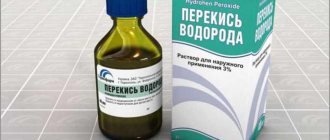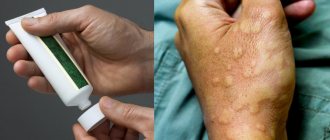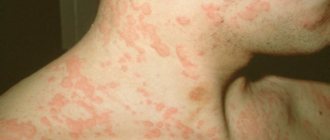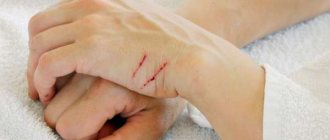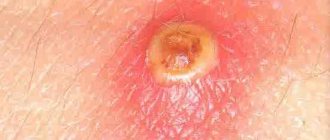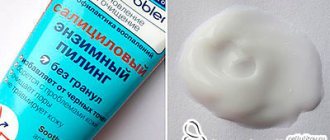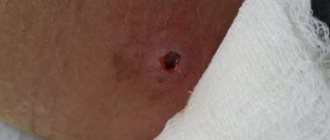H1 CC
Skip to content
- cosmetologist
- Contacts
Home »Health »Getting rid of papillomas and warts
Keratopapilloma of the skin differs from other types of growths in that it does not appear as a result of infection with the papilloma virus. The formation of dark or even brown papilloma occurs due to age-related changes. This wart, popularly called a senile wart, grows for many years and must be carefully monitored, since there are cases of degeneration of this benign neoplasm into a malignant one.
What is keratopapilloma
Keratopapillomas are commonly called keratinized papillomas. They usually occur in people aged 35-40 years. Viral rashes are often diagnosed on the neck, face, groin and axillary area. Their shape can be very different.
Keratopapillomas are small and large. Sometimes they reach the size of a hazelnut. The surface of the tumor is either smooth or slightly rough. As for the color of the growth, it can be either flesh-colored or dark brown. These rashes are easily injured, since they are attached to the body by a very thin stalk.
Keratopapillomas vary in color and shape
The disease can be found in the ICD 10 list. It is listed there under code D23.
Causes
Keratopapillomas do not appear in young people and children. This is because their body is able to cope with this disease. In people of older age groups, the immune system gradually weakens, due to which their body becomes susceptible to attack by various viruses.
Keratomas cannot be called a consequence of infection with the human papillomavirus. They are formed due to disturbances in the functioning of individual systems and internal organs. This pathology is often hereditary. So if parents had this disease, then in 90% of cases it is one day detected in their children.
The following factors can provoke the development and increase in the number of keratopapillomas on the skin:
- Long-term use of diuretics, antibiotics and immunosuppressants;
- Lack of retinol;
- Malfunctions of the autonomic system;
- Metabolic disease;
- Endocrine diseases;
- Gastrointestinal pathologies;
- Frequent visits to the solarium;
- Wearing clothes that are too tight.
Any of these factors can cause an exacerbation of the disease in a person who is predisposed to it.
General characteristics
After entering the body, the virus does not always immediately begin active growth and development. In the usual case, the “sleep” mode lasts for some time, which in medicine is called incubation. Its exact duration depends on the health of the infected person and the level of the body’s defenses.
In a patient with a weak immune system, symptoms may appear within a couple of months. If a person has an excellent immune system, the virus will not be able to disturb him until it becomes weaker. If this happens after two years, then the infection will begin to become active only after two years.
How can you recognize that the virus is actively developing: small papillae appear on the epithelial tissue. At first they cannot always be distinguished, but over time they grow into such large formations that they become difficult to hide from prying eyes.
Symptoms
Recognizing the disease is not so easy. Patients realize that they are sick only after strange growths begin to form on their body. They protrude slightly above the top layer of skin. After some time, the tumor may increase in size. A dense crust will appear on it, which will begin to peel off.
Keratoma is often multiple. Growths appear on exposed areas of the body, which is why people perceive them as a cosmetic defect. The injured rash will begin to hurt and bleed. If these symptoms occur, you should consult a doctor immediately. He will tell you how to treat a benign tumor, avoiding serious complications.
How does the disease develop?
Very often, a person who is at risk of contracting this disease has sensitive skin. It reacts sharply to exposure to ultraviolet rays emitted by the sun. As a result, the following happens:
- The stratum corneum gradually expands in size.
- A little later, a speck of grayish or brown color with dirt forms.
- The problem area of epithelial tissue becomes rough.
- This area usually becomes very dense and thick.
- Over time, a crust forms on the surface, which tends to crumble and fall off as the disease develops.
In this case, quite a lot of discomfort is felt, because the symptoms are usually accompanied by the appearance of blood flow and severe pain.
Diagnostics
An experienced specialist can recognize keratopapilloma during a visual examination of the problematic growth. Sometimes even an ordinary person can cope with such a task. To do this, it is enough to compare the neoplasms on your body and in the photo, which shows the area affected by the disease.
Many neoplasms are similar to each other; only a doctor can determine the type
In order to make sure that their conclusions are correct, the doctor will send the patient to undergo a series of studies and tests. These include the following procedures:
- Dermatoscopy;
- Biopsy of keratoma tissue;
- Ultrasound of the affected area;
- Siascopy.
The last diagnostic option is based on intradermal spectrophotometric analysis. It helps to accurately determine the nature and type of benign neoplasm.
Definition
First you need to figure out what it is - keratopapilloma, and how to recognize it in time. Keratopapilloma is a benign neoplasm, one of the types of papillomas. This neoplasm often has a convex shape and is attached to the skin with a thin stalk (depending on the type). It differs from ordinary papillomas in the keratinization of the surface and the presence of peeling.
Sizes range from fairly small to large (up to the size of a hazelnut). The number of neoplasms also varies, from 1-2 to several hundred. Most often, keratopapillomas are localized on the face, neck, armpits, groin and lower back. There are also cases of keratopapilloma of the auricle in medical practice.
Kinds
Keratopapilloma of the skin comes in different types. Each of them has its own characteristics. Thanks to them, the specialist correctly determines the type of disease and selects the most optimal treatment method for it. You can see the differences between different keratopapillomas if you study in detail the photos depicting them.
Seborrheic
If the keratoma is seborrheic, then initially yellowish spots will form on the skin. By the time they finally ripen, they are covered with a dense crust. If you handle the problem area carelessly, the growths may crack. Damage to them causes pain. It is strictly forbidden to open the crust. This will cause bleeding.
As a rule, seborrheic keratoma is formed due to dysfunction of the sebaceous glands. A growth of this type is indicated by the following signs:
- Itching in the affected area;
- Size up to 6 cm;
- Round shape;
- Ability to change color to darker.
Seborrheic keratoma causes a lot of discomfort. Therefore, patients want to get rid of the itchy rash immediately.
Senile
Keratoma of this type grows in older people. Hence the name. Its appearance is provoked by physiological processes that occur in the body. Many people don't pay much attention to them because they don't hurt or itch.
Senile keratopapillomas can be gray, black or brown in color. They are flat, plaque or nodular in shape. In some cases, the growths simply merge with the skin. Although more often they protrude slightly above its surface.
Horny
Horny ceranomas are small, brown or gray colored lumps. They are covered with a dense crust that constantly peels off. In their appearance, the neoplasms strongly resemble filiform papillomas. This is because keratomas are capable of extending 1 cm above the surface of the skin.
Typically, horny growths appear on people's neck and face.
Horny keratoma owes its name to its shape
Follicular
Anyone who has encountered a follicular keratoma knows that it is flesh-colored or pink in color, and does not exceed 1.5 cm in diameter. Another characteristic sign of growth is fairly clear boundaries.
Such keratopapillomas occur on the scalp. They are usually located between the nose and upper lip, as well as along the hairline. In appearance, the growths resemble small nodules, the surface of which is covered with uneven tubercles.
This is one of the few types of rashes that are localized on the scalp.
Follicular keratoma occurs on the scalp
Solar
Such tumors grow on the skin due to exposure to ultraviolet rays. This explains why solar keratopapillomas occur mainly on exposed areas of the body. Small rashes often merge into a single plaque of a fairly large size. It peels off a lot and over time changes its natural flesh color to brown or black.
Angiokeratomas
These rashes are usually considered to be one of the types of keratopapillomas. They can be single or multiple. Angikeratomas occur not only in adults, but also in young children. This is one of the features of neoplasms.
Angikeratomas are recognized by the following characteristics:
- Size up to 1 cm;
- Dark color (purple, brown or black);
- Irregular shape;
- Fuzzy edges.
Angiokeratoma can also occur in children
It is difficult to say which type of neoplasm is the problem. Doctors say that it is most difficult for patients diagnosed with seborrheic keratoma, as they are constantly bothered by unbearable itching.
Electrocoagulation
This type of treatment is based on the use of electric current of variable or constant frequency. During the procedure, a metal electrode is applied to the neoplasms, resulting in a burn that is very limited in area. In other words, they only affect keratopapilloma and nearby blood vessels. Thanks to this, the tumor is removed and bleeding does not occur (the vessels are cauterized).
Doctors consider this treatment as one of the most effective:
- All types of tumors can be treated in this way;
- the effect is achieved in 1 session;
- no anesthetic is required to remove small keratopapillomas;
- The price of the procedure is quite affordable.
The disadvantages include the appearance of scars after removal (occurs when large areas of skin are affected).
What is the danger of keratopapilloma formation?
Most benign formations on the skin are completely safe for humans. They only cause aesthetic discomfort. Sufficiently large keratopapillomas can become a real problem for a person who is very concerned about his appearance.
Keratopapillomas, which are constantly exposed to mechanical stress, for example, rubbing against clothing, may not be too harmless. At any moment the growth may become injured. And this increases the likelihood of infection of the affected skin area.
There are certain types of keratoma, which may one day turn into a malignant tumor. You can suspect that a growth has degenerated into cancer based on the following symptoms:
- The appearance of pain when pressing on the formation;
- Inflammation of tissue next to keratopapilloma;
- Continuous itching;
- Regular bleeding from the growth.
These signs should alert a person and force him to urgently make an appointment with a doctor.
Drug therapy
Drug treatment of keratopapilloma - what is it? Medicines are prescribed by doctors taking into account the general condition of the patients, the causes and stage of development of the disease.
- Cytostatics. These drugs are prescribed in cases where there is a high risk of a benign neoplasm becoming malignant. Typical representatives of this group: “Methotrexate”, “Prospidin”, “Cyclophosphamide”, used for local administration.
- Antitumor antibiotics.
- Local anti-inflammatory. In cases where the skin around the keratopapilloma has redness and inflammation, local anti-inflammatory medications are prescribed. Diclofenac gel showed good effectiveness.
- Hormonal. Such medications can help cope with swelling, itching and burning. Used topically. These medications should only be used under medical supervision.
- Mummifying and cauterizing. For seborrheic keratopapilloma, local preparations based on concentrated acids are often prescribed. One of them is Solcoderm.
Treatment
If the disease is not advanced, then doctors suggest limiting ourselves to conservative treatment of keratopapilloma. It consists of taking vitamin complexes to strengthen the immune system and using hormonal ointment, which should be used to regularly treat the growth to eliminate inflammation and stop metabolic processes within the formation. Even if the therapy does not help completely get rid of the keratoma, it will still prevent the appearance of new keratinized rashes, which is also considered a good result.
Radio wave therapy
This is another method of treating keratopapilloma, which can be considered one of the most advanced. It differs from many other methods of exposure in that it is safe for healthy tissues, because it does not use a scalpel or current, but radio waves.
Undoubted advantages:
- versatility - radio wave treatment is indicated for diagnosing benign and malignant neoplasms (including keratopapilloma of the auricle);
- gentle effect - healthy tissues are not involved, so there are no scars left after the procedure;
- the ability to process all types of tissue (even mucous membranes);
- Painlessness—radio wave treatment does not require anesthesia.
This option is not suitable for all patients, as there are some contraindications (pregnancy and lactation, herpes infection, menstruation, allergic reactions, pustular and inflammatory formations).
Removal
If the neoplasm causes discomfort or it may develop into a cancerous tumor in the future, then doctors will recommend removal of the resulting keratopapilloma. This procedure is carried out using hardware methods:
- Surgical excision;
- Electrocoagulation;
- Radio wave therapy;
- Laser therapy;
- Cryodestruction.
The specialist will select the most suitable method for removing benign keratoma. This point must be discussed with the patient. Experts usually advise eliminating problematic growths with a laser, as this is the most modern method of radical treatment of skin rashes.
Laser removal is a bloodless and low-traumatic method
Surgical method
This method of treatment is considered one of the oldest and involves removing keratopapilloma with a scalpel. Among the undoubted advantages of this method:
- versatility (suitable for the treatment of benign and malignant tumors);
- effectiveness - after removing the tumor, the problem disappears;
- affordable price - of all the options offered, surgical removal is considered the cheapest.
One of the disadvantages is the complete dependence of the result on the professionalism of the surgeons, since the human factor plays a big role here.
Folk remedies
If keratopapilloma has appeared recently, then treatment with folk remedies is suitable. With this diagnosis, the following may help:
- Potato. A paste is made from fresh tubers, which is applied to the growth and fixed with cotton cloth and cling film. The procedure lasts about 40 minutes. The course of treatment is 2-3 weeks;
- Aloe. The leaves of the plant that have lain for 3 days are thawed and applied to the problem area, carefully secured with an adhesive plaster. The procedure is carried out daily for 3 weeks;
- Walnut. A balm is made from unripe fruits to lubricate new growths. To prepare it, you need to pour warm vegetable oil (ratio 1:6) over the nuts and leave it in a thermos for 24 hours. Such treatment should last no more than 2 weeks;
- Juniper and bay leaves. They are mixed with fir and butter. The prepared mixture is applied to the keratoma every day.
If folk remedies do not work, it is better to agree to remove keratopapilloma using a hardware method, for example, a laser.
Also, one should not forget about increasing immunity, which suppresses the activity of pathogenic processes inside the body.
Prevention
Following a number of rules helps reduce the likelihood of keratoma:
- Avoid prolonged exposure to ultraviolet radiation;
- Do not come into contact with hazardous chemicals;
- Treat chronic diseases;
- To live an active lifestyle;
- Provide yourself with a balanced diet;
- Protect skin from the sun, especially in summer.
If a person takes care of his own skin and the body as a whole, then he is unlikely to ever be bothered by keratopapillomas.
Preventive measures
Any health problem is much easier to prevent than to treat. This rule also works in the case of keratopapillomas. A few simple measures will help prevent their occurrence. Among them there will definitely be the following:
- Eliminating or minimizing contact with harmful chemicals. If this is not possible, then it is necessary to protect exposed areas as much as possible from the negative effects of chemicals and their accidental contact with the surface of the skin.
- Maximum reduction in duration of exposure to ultraviolet rays. You should limit your time spent on the beach or in the solarium.
- Taking timely measures to treat various chronic diseases. It is recommended not to start the problem, but to treat it at the initial stage of exacerbation.
- Quitting smoking and drugs, as well as drinking alcohol.
- Leading an active lifestyle and regular physical exercise. Doctors advise frequent walking, short jogging in the fresh air and swimming in the pool.
- Ensuring protection of the skin surface from the negative effects of direct sunlight. In this case, you can use special ointments or wear long sleeves.
- Preparation of a correct and balanced daily diet. It should include vitamin-rich foods and meals containing the daily protein requirement.
Keratopapilloma is considered a fairly common problem. You can fight it with the help of medicine or folk remedies. If you diagnose the disease in time and quickly begin treatment, you can avoid serious consequences and any side effects.
